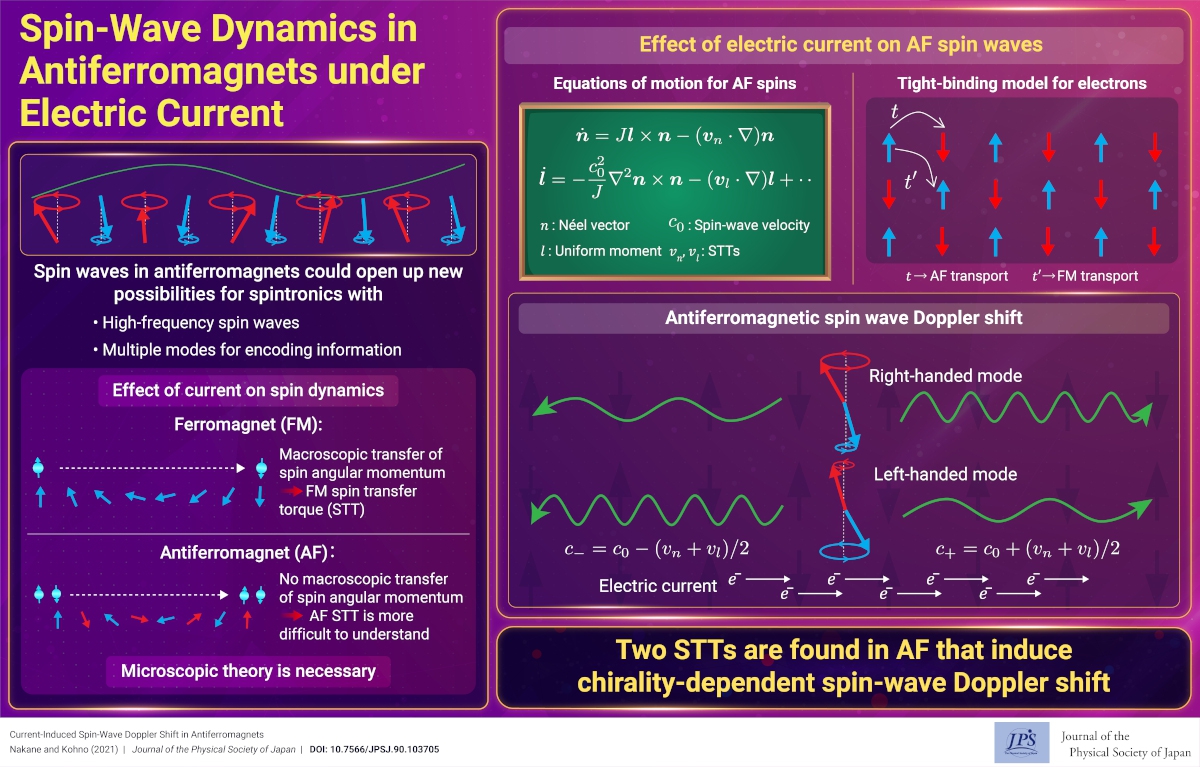Spin-Wave Dynamics in Antiferromagnets under Electric Current
© The Physical Society of Japan
This article is on
Current-Induced Spin-Wave Doppler Shift in Antiferromagnets
J. Phys. Soc. Jpn. 90, 103705 (2021).
Electric current causes a Doppler effect in spin waves in ferromagnets through a spin-transfer torque. We report that antiferromagnets allow two such spin-transfer torques and present a microscopic analysis that interpolates ferro- and antiferromagnetic transport regimes.

Investigating the effect of electric current on magnetic materials is crucial in spintronics. In ferromagnets, electric currents are known to drive domain-wall motion and cause a Doppler shift in the spin-wave spectrum. These phenomena, known as the spin-transfer effect, can be understood as the exchange of spin angular momentum between magnetization and conduction electrons. In antiferromagnets, neither the conduction electrons nor antiferromagnetic spins carry macroscopic spin angular momentum, and the spin-transfer effect is not intuitively understood, calling for a microscopic analysis.
It was long supposed that there is only one (reactive) spin-transfer torque in antiferromagnets, as in ferromagnets. In this study, starting from a microscopic Hamiltonian with conduction electrons, we show that antiferromagnets have two different types of spin-transfer torques: one arising through the coupling to the uniform spin density ( ) and the other through the staggered spin density ( ). The two spin-transfer torques make equal contributions of to the spin-wave Doppler shift, while only one ( ) acts on domain walls [1]. This feature is in stark contrast to ferromagnets, in which a single spin-transfer torque leads to both Doppler shift and domain-wall motion. The Doppler shift depends on chirality of antiferromagnetic magnons, thus an electric current can be used to differentiate the two modes via the shift in wavelength or frequency.
We microscopically calculated the spin-transfer torques due to electrons on a two-dimensional square lattice by considering not only the nearest-neighbor (inter-sublattice) hopping but also the next-nearest-neighbor (intra-sublattice) hopping; the former induces “antiferromagnetic transport” in the sense that the electrons feel the alternating magnetization, whereas the latter induces “ferromagnetic transport,” rendering the electrons feel a uniform magnetization. One can interpolate the two transport regimes (ferromagnetic and antiferromagnetic) by varying the hopping parameters. In the limit of ferromagnetic transport, the two spin-transfer torques reduce to the well-known spin-transfer torque in a ferromagnet. In the antiferromagnetic transport regime, the two torques collaborate or compete, and the overall Doppler shift depends on microscopic parameters (such as band filling); it is negative (same sign as for ferromagnets) at small band filling and changes sign as the lower band becomes filled towards the antiferromagnetic band gap.
[1] J. J. Nakane and H. Kohno, Phys. Rev. B 103, L180405 (2021).
(Written by J. Nakane on behalf of all authors)
Current-Induced Spin-Wave Doppler Shift in Antiferromagnets
J. Phys. Soc. Jpn. 90, 103705 (2021).
Share this topic
Fields
Related Articles
-
Conversion of Chiral Phonons into Magnons in Magnets
Electronic transport in condensed matter
2024-4-1
A new phenomenon involving the conversion of chiral phonons into magnons is theoretically predicted. The effective magnetic field induced by chiral phonons causes a change in the spin magnetization of magnets.
-
Variety of Mechanically Induced Spin Currents in Rashba Systems
Electronic transport in condensed matter
Magnetic properties in condensed matter
Structure and mechanical and thermal properties in condensed matter
2024-3-22
Various types of spin currents, including unconventional types, are generated in Rashba spin-orbit coupled systems by dynamic lattice distortions associated with, for example, surface acoustic waves.
-
What Determines the Sign of Spin Current? ~ Theoretical Study of Spin Seebeck Effect in Antiferromagnetic Insulators
Electronic transport in condensed matter
2024-3-18
We developed a microscopic theory for the spin Seebeck effect in antiferromagnets, that explains the sign reversal of the spin current at the spin-flop transition point and describes the sorts of dominant carriers.
-
Chiral Anomalies in Organic Dirac Semimetals
Electronic transport in condensed matter
2024-2-5
A three-dimensional massless Dirac fermion system exhibiting broken chiral symmetry was successfully realized in organic conductor α-(BEDT-TTF)2I3 under high pressures. Our study detected the chiral anomaly-induced negative magnetoresistance and planar Hall effects and opened new avenues for further advancements in the field.
-
Thermodynamic Property of a CMOS Device beyond Landauer Limit
Statistical physics and thermodynamics
Electronic transport in condensed matter
Cross-disciplinary physics and related areas of science and technology
2024-1-23
Focusing on a CMOS NAND GATE operating in a sub-threshold region, the thermodynamic cost of computation was analyzed in relation to input/output voltages surpassing the Landauer limit.
